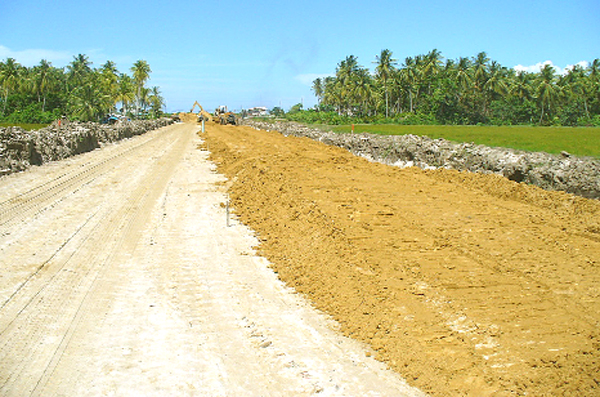By Shabna Ullah
Work on the Berbice River Bridge is progressing with the high span completed and the slopes almost in position to allow for a free flow of maritime traffic before work continues on the retractor span.
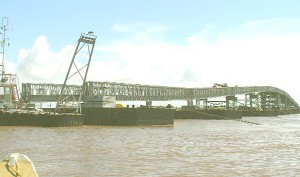
An official with the bridge project told Stabroek News that “the high span has to start functioning first for us to continue working on the navigation channel [where the retractor span would be located].”
The installation of the five slopes on the eastern side of the high span is almost completed. This would be joined by two more spans to connect to the abutment at Crab Island. On the western side, four out of the five sloping spans have already been installed.
The official said too that they have already started to install the cluster piles with lights for the free movement of vessels at night. An advertisement informing maritime traffic about piles was also shown on television in Berbice.
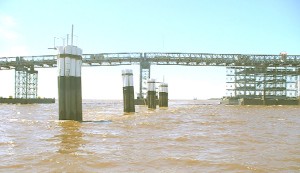
During the second media tour of the bridge on May 15, Bert Carter, chairman of the technical team had told reporters that the last section of the bridge to be constructed is the retractor span. The bridge which would be less than two miles long would be fitted with a total of 39.
Carter had said that upon completion of the high span, maritime traffic, especially from the bauxite company, Oldendorf would be able to pass under the high span unimpeded as installation of the other spans continues.
The height under the retractor span is 40 feet while the distance between the two pontoons that support the high span is 120 feet.
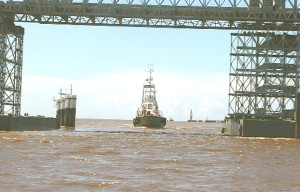
Carter had told reporters that when completed, the bridge will be the sixth longest floating bridge in the world at 1,570.719 metres. The Demerara Harbour Bridge is the fourth longest of its kind in the world. The Berbice Bridge will be shorter than the Demerara Harbour Bridge but the width will be the same, about 22 feet.
Seventeen spans have been positioned on the western side while the first and second spans have been left out to avoid persons going onto the bridge.
The original design of the bridge, which is said to have a lifespan of over 30 years and costs almost US$40M, was for the high span to be positioned on the western end of the bridge.
But the design was adjusted for the high span to be placed at the eastern end. The change was made to facilitate a better flow of the river traffic.
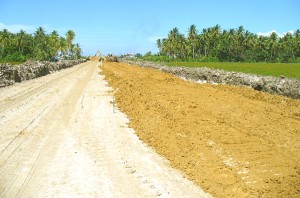
The abutment piles which are already in place would “have to be tied back on the land. The second tie back is in place to close off the western abutment.”
This newspaper was told also that sanitary blocks are being constructed on the eastern and western side “for staff and for the public.”
According to the official, two generator stations have been built on both sides and the generators now have to be installed. He said too that the construction of a security building is in progress.
Toll
Upon completion the administrative building and the toll plaza would be established at D’Edward. While tolls would only be collected on the western side of the bridge, a mini toll station would also be erected on the eastern side.
Vehicles would be allowed to cross with up to 40 tonnes and trucks would have to be weighed and may have to pay another toll, depending on the weight.
The average toll for a vehicle will be around $1,400 [costs would vary for different classes of vehicles] but no charge will be levied for individual passengers. This amount was calculated on the basis of a formula intended to secure sufficient revenue to cover all operating and maintenance costs, return on investment and repayment on financing.
Chairman of the Berbice Bridge Company Inc, Geeta Singh-Knight had said that the contractors – Bosch Rexroth and Mabey & Johnson – would be handing over a fully lit bridge, including on the high span [and under the high span for the ships] and retractor span as well as lighting on both ends of the access roads.
Deadline
The deadline for the completion of the bridge has been set for September and the official is hopeful that this would be met. The official also believes that the road would be “drivable” by next month, if not completed.
“You do not have to get a completed road for it to be passable. Work could still go on even after the bridge is opened to the public,” he said.
The contract for the road project was signed for US$8.7M and was undertaken by Dipcon Contracting Company.
This newspaper visited the access road at Crab Island and was transported along it to the Palmyra end. The laying of reef sand – of which 30% is mixed with white sand – was in progress at both ends.
However officials told this newspaper that they are facing a setback with the inclement weather as well as with sourcing the reef sand from the backlands [due to poor dams] for the Crab Island side.
In efforts to meet the deadline, they attempted to upgrade the access dam at Cotton Tree. Unfortunately the night before they had planned to traverse the dam the rain “washed out” their efforts. They are in the process now of sourcing the sand from another area.
Leslie Wason, a consultant/Inspector of Works with the ND Lea consulting firm, told Stabroek News that the most technical part has been completed, referring to the linking of the two roads.
He too is confident that the access road can be completed on schedule but said the workers have to redouble their efforts and work late at nights. He said that after applying the reef sand, workers would top it with crusher run before laying the asphalt. According to him, “once the weather permits the work can be done in one month.”
He pointed out that the access road at D’Edward is currently receiving the final layer of reef sand.
A superintendent with Dipcon, Kumar Bickram said that two culverts are being constructed – a C22 that links Crab Island to Palmyra as well as a C9 – and they are both 50% completed.
Rawleston Adams, senior engineer with the Ministry of Public Works had told the media during the tour that the road is expected to be completed in two phases. The asphalt project should be finished by the first week in September in time for the commencement of the bridge operations.
The completion of the contract, he said, is set for April 2009, “giving the contractor another six months in terms of tidying up to install street lights and mark the road…”

